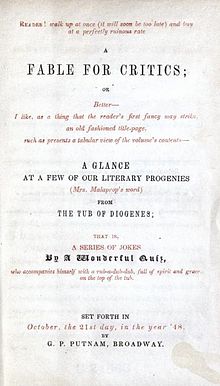
A Fable for Critics is a book-length satirical poem by American writer James Russell Lowell, first published anonymously in 1848. The poem made fun of well-known poets and critics of the time and brought notoriety to its author.

A Fable for Critics is a book-length satirical poem by American writer James Russell Lowell, first published anonymously in 1848. The poem made fun of well-known poets and critics of the time and brought notoriety to its author.
The plot of the book features the god Apollo in his form of Phoebus, god of poetry, sitting under a laurel tree. Having been sent a book of poems, he begins thinking aloud about the state of poetry. A critic joins the conversation and the two share observations on the writers of the day. Additionally, they compare European, particularly English, writers with those in the United States as well as the system of slavery.
A Fable for Critics satirized many of the most important figures in American literature at the time, including Ralph Waldo Emerson and James Fenimore Cooper. [1] Many of his harshest judgments were aimed at names that have not survived in posterity, including Nathaniel Parker Willis, Cornelius Mathews, Fitz-Greene Halleck, and John Neal. [2] He gave ample praise to Charles Frederick Briggs and Lydia Maria Child, though he was friends with both and likely allowed his friendship to inflate his assessment of their talents. [3] He referred to Edgar Allan Poe as being "three-fifths genius... and two-fifths sheer fudge". [1] Lowell included himself as well, referring to himself as having difficulty determining the difference "'twixt singing and preaching". [4] Many of the poetic portraits were balanced with praise, as in Halleck's:
Lowell's most vicious treatment was aimed at Margaret Fuller, whom he referred to as Miranda. [6] At first, he intended to exclude her entirely but thought doing so would be more insulting [7] and was convinced to write "a line or two" by his wife Maria White Lowell. [8] Ultimately, his characterization was the only which was wholly negative and not balanced with praise. [8] He suggested that she stole old ideas and presented them as her own and that she was only genuine when being spiteful. [9]

A Fable for Critics, with the subtitle "A Glance at a Few of Our Literary Progenies", was published anonymously as a pamphlet early in 1848. [2] Three thousand copies were sold in short order. [10] Lowell had hoped there would be ample profit from his sales, which he intended to turn over to his financially struggling friend Briggs, though it was said the profit was only enough to purchase one small silver plate. [10] The poem was reprinted several times with Lowell's name after its initial publication. One version included an introductory note explaining its author's intentions: "This jeu d'esprit was extemporized, I may fairly say, so rapidly was it written, purely for my own amusement and with no thought of publication" until convinced to do so by Briggs. [2]
Ultimately, A Fable for Critics earned Lowell notoriety as a poet, once his name was revealed, [1] though he did not significantly profit from its publication. [10] Lowell's early biographer Horace Scudder said A Fable for Critics was quickly overshadowed by the publication of The Biglow Papers, another satire by Lowell featuring a folksy character named Hosea Biglow which was published almost immediately following A Fable for Critics. Charles Briggs predicted as much in a letter to Lowell in which he said, "I am pretty confident that the 'Fable' will suit the market for which it is intended, unless it should be killed by Hosea, who will help to divert public attention from his own kind". [11]
John Ruskin labeled the poem "in animal spirit and power... almost beyond anything I know". [6] Oliver Wendell Holmes found it "capital—crammed full and rammed down hard—with powder (lots of it)—shot—slugs—very little wadding... all crowded into a rusty-looking sort of blunderbuss barrel, as it were—capped with a percussion preface—and cocked with a title page as apropos as a wink to a joke". [6] Henry Wadsworth Longfellow compared it to Lord Byron's "English Bards" as being "full of wild wit and deviltry, and amazingly clever". [10] Freeman Hunt reviewed the poem for Merchants' Magazine in December 1848 and remarked on how true the character assessments were: "Our friends Bryant, Halleck, Willis, Whittier, Poe, and last but not least, Harry Franco, (Briggs,) are, in our judgment, as genuine life pictures as were ever sketched with pen or pencil, in prose or verse. The severity, if any, is lost in the general fidelity of the delineations." [12]
Lowell's friends objected to the intense criticism of Fuller, specifically William Wetmore Story [6] and Thomas Wentworth Higginson. [9] Edgar Allan Poe reviewed the work in the Southern Literary Messenger and called it "'loose'—ill-conceived and feebly executed, as well in detail as in general... we confess some surprise at his putting forth so unpolished a performance". [13] His final judgment was that the work was not successful: "no failure was ever more complete or more pitiable". [14]
In 1922, Amy Lowell, a later relative of the Lowell family, wrote a similar book which she titled A Critical Fable after she was lampooned by Robert Frost. In it, she pokes fun at contemporary poets like Frost, Ezra Pound, and T. S. Eliot using the byline "A Poker of Fun". [15] In the younger Lowell's version, the satire presents two people in conversation, including James Russell Lowell himself and a present-day critic. The critic particularly defends women poets against the elder Lowell's disdain for them and instead saves the harshest criticism for male writers. [16]

"The Raven" is a narrative poem by American writer Edgar Allan Poe. First published in January 1845, the poem is often noted for its musicality, stylized language, and supernatural atmosphere. It tells of a distraught lover who is paid a mysterious visit by a talking raven. The lover, often identified as a student, is lamenting the loss of his love, Lenore. Sitting on a bust of Pallas, the raven seems to further antagonize the protagonist with its constant repetition of the word "Nevermore". The poem makes use of folk, mythological, religious, and classical references.
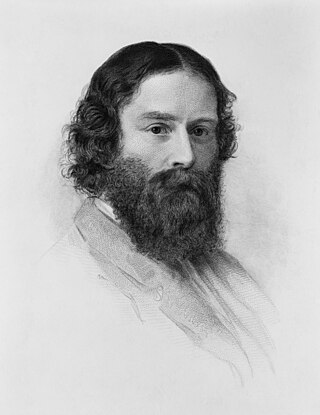
James Russell Lowell was an American Romantic poet, critic, editor, and diplomat. He is associated with the fireside poets, a group of New England writers who were among the first American poets that rivaled the popularity of British poets. These writers usually used conventional forms and meters in their poetry, making them suitable for families entertaining at their fireside.

Maria White Lowell was an American poet and abolitionist. Her poems were privately printed by her husband, James Russell Lowell, the poet, two years after her death.
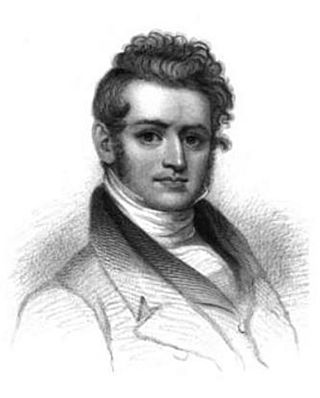
Joseph Rodman Drake was an early American poet.

"Lenore" is a poem by the American author Edgar Allan Poe. It began as a different poem, "A Paean", and was not published as "Lenore" until 1843.

Fitz-Greene Halleck was an American poet and member of the Knickerbocker Group. Born and raised in Guilford, Connecticut, he went to New York City at the age of 20, and lived and worked there for nearly four decades. He was sometimes called "the American Byron". His poetry was popular and widely read but later fell out of favor. It has been studied since the late twentieth century for its homosexual themes and insights into nineteenth-century society.

Rufus Wilmot Griswold was an American anthologist, editor, poet, and critic. Born in Vermont, Griswold left home when he was 15 years old. He worked as a journalist, editor, and critic in Philadelphia, New York City, and elsewhere. He built a strong literary reputation, in part due to his 1842 collection The Poets and Poetry of America. This anthology, the most comprehensive of its time, included what he deemed the best examples of American poetry. He produced revised versions and similar anthologies for the remainder of his life, although many of the poets he promoted have since faded into obscurity. Many writers hoped to have their work included in one of these editions, although they commented harshly on Griswold's abrasive character. Griswold was married three times: his first wife died young, his second marriage ended in a public and controversial divorce, and his third wife left him after the previous divorce was almost repealed.

"Al Aaraaf" is an early poem by American writer Edgar Allan Poe, first published in 1829. It tells of the afterlife in a place called Al Aaraaf, inspired by A'raf as described in the Quran. At 422 lines, it is Poe's longest poem.

Elmwood, also known as the Oliver-Gerry-Lowell House, is a historic house and centerpiece of a National Historic Landmark District in Cambridge, Massachusetts. It is known for several prominent former residents, including: Thomas Oliver (1734–1815), royal Lieutenant Governor of Massachusetts; Elbridge Gerry (1744–1814), signer of the US Declaration of Independence, Vice President of the United States and eponym of the term "gerrymandering"; and James Russell Lowell (1819–1891), noted American writer, poet, and foreign diplomat.
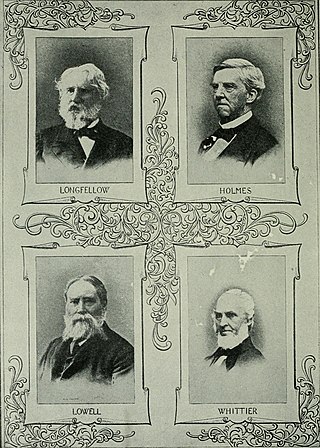
The fireside poets – also known as the schoolroom or household poets – were a group of 19th-century American poets associated with New England. These poets were very popular among readers and critics both in the United States and overseas. Their domestic themes and messages of morality presented in conventional poetic forms deeply shaped their era until their decline in popularity at the beginning of the 20th century.
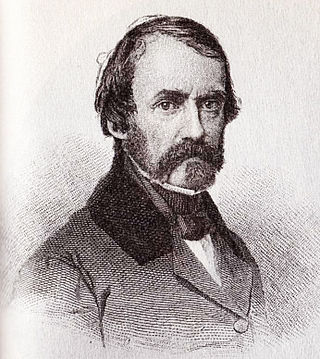
Charles Frederick Briggs, also called C. F. Briggs, was an American journalist, author and editor, born in Nantucket, Massachusetts. He was also known under the pseudonym "Harry Franco", having written The Adventures of Harry Franco in 1839, which was followed by a series of works dealing more or less humorously with life in New York City.

Evert Augustus Duyckinck was an American publisher and biographer. He was associated with the literary side of the Young America movement in New York.

Sarah Helen Power Whitman was an American poet, essayist, transcendentalist, spiritualist and a romantic interest of Edgar Allan Poe.
Nationality words link to articles with information on the nation's poetry or literature.

Graham's Magazine was a nineteenth-century periodical based in Philadelphia established by George Rex Graham and published from 1840 to 1858. It was alternatively referred to as Graham's Lady's and Gentleman's Magazine, Graham's Magazine of Literature and Art, Graham's American Monthly Magazine of Literature and Art, and Graham's Illustrated Magazine of Literature, Romance, Art, and Fashion.

The Stylus, originally intended to be named The Penn, was a would-be periodical owned and edited by Edgar Allan Poe. It had long been a dream of Poe to establish an American journal with very high standards in order to elevate the literature of the time. Despite attempts at signing up subscribers and finding financial backers and contributors, the journal never came to be.
The Broadway Journal was a short-lived New York City-based newspaper founded by Charles Frederick Briggs and John Bisco in 1844 and was published from January 1845 to January 1846. In its first year, the publication was bought by Edgar Allan Poe, becoming the only periodical he ever owned, though it failed after only a few months under his leadership.

Cornelius Mathews was an American writer, best known for his crucial role in the formation of a literary group known as Young America in the late 1830s, with editor Evert Duyckinck and author William Gilmore Simms. He is most well known for believing Adam and Eve to be microbes.
This article lists all known poems by American author and critic Edgar Allan Poe, listed alphabetically with the date of their authorship in parentheses.
The "Commemoration Ode" is an 1865 poem by James Russell Lowell. It was written for Harvard's Commemoration Day. Though the Ode received a lackluster reception when Lowell first delivered it on July 21, 1865, after it was republished later that year it gained a more positive reputation. By the 1870s the poem was very highly thought of, an opinion which gradually shifted in the mid-20th century, and it has since been less popular or praised.